Water rights and traditional water harvesting has a long history in India. The most striking feature of traditional water harvesting systems is that the people had the right to construct and manage them. There is ample evidence throughout the country to show that historically, even when the State financed the construction of water infrastructure structures, the ultimate responsibility of devising the distribution and maintenance systems was left to the local communities.
Traditional water harvesting may not be sufficient for today’s needs in all places. In many areas, the traditional systems have been irretrievably destroyed. As such, a balanced mixof the traditional along with the large and modern water infrastructure is needed. But the first priority should be on localized traditional systems, which the community understands and is able to manage from its own resources both in term of labour and finance.
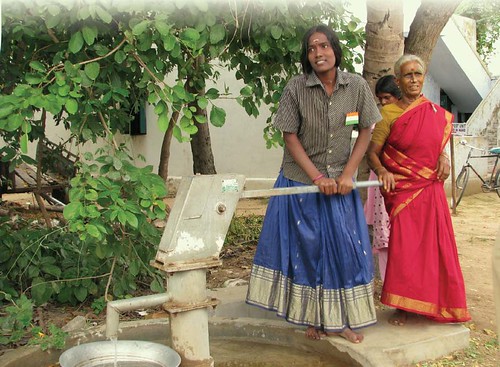 Ground water resource development in India is carried out by the Government as well asindividual farmers and industry. Constant depletion and seasonal fluctuations in the groundwater table, which is the prime source of drinking water especially in rural areas, are affecting the productivity of aquifers and also water quality is deteriorating.
Ground water resource development in India is carried out by the Government as well asindividual farmers and industry. Constant depletion and seasonal fluctuations in the groundwater table, which is the prime source of drinking water especially in rural areas, are affecting the productivity of aquifers and also water quality is deteriorating.Apart from rooftop rainwater harvesting for providing drinking water to individual households, the collection and storage of surface flood runoffs during high rainfall can also be utilized as a supplement to the existing water supply schemes providing drinking water security during drought. Rooftop rainwater can also recharge groundwater reservoirs through abandoned dugwells, defunct handpumps, recharge pits, recharge trenches, recharge shafts etc.Sustained advocacy and capacity development of the PRI s, NG Os and the community organizations in promoting adoption of rainwater harvesting is very critical.
Case Study
The village Hamirpur in block Datia of Datia district, Madhya Pradesh with a population of 641, majority of whom belong to scheduled castes and scheduled tribes, falls in Bundelkhand region and faces acute shortage of water and regular drought like situation due to erratic rainfall pattern. Overall rainy days have gone down, from 100 days (740 mmaverage) two decades ago to an average (340 mm) of 40 rain days today.
Local Initiative
The Village Water and Sanitation Committee (VWSC), also known as PayJal Samiti was, constituted for taking up water supply scheme for the village under Swajaldhara programme and also collected Rs. 40,000 as community contribution but could not get necessary approvals.
New Concept
The villagers after a series of meetings decided to take their own initiative and adopted ‘Integrated Water Resource Management’ for improving the groundwater level of the village and for successful implementation of water supply scheme in the near future. For recharging and conservation of rainwater, a plan was made to construct rainwaterharvesting structures in all houses; well deepening and recharging trench on abandoned community open wells and tubewells and construction of check dams.
They also identified a place outside the village from where soil for construction of houses and roads was to be dugout and taken away so as to create a huge pond for recharging the handpumps and the groundwater aquifer.
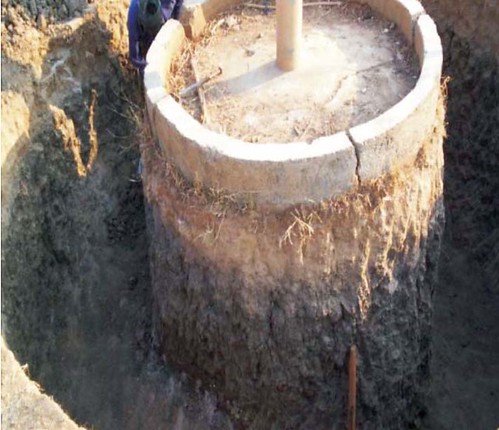
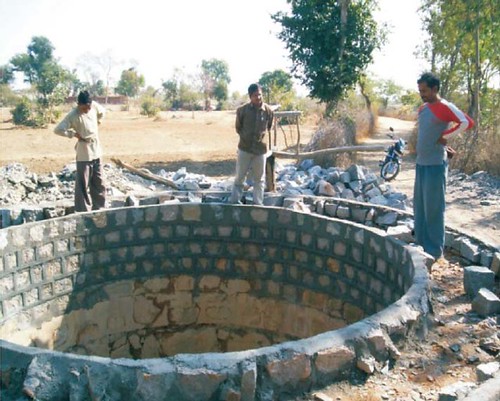 The Public Health Engineering Department (PHED) constructed a dyke-cum-boulder damin the village and checkdams across the nalas in other villages that resulted in recharging a large number of handpumps installed upstream of the checkdam.
The Public Health Engineering Department (PHED) constructed a dyke-cum-boulder damin the village and checkdams across the nalas in other villages that resulted in recharging a large number of handpumps installed upstream of the checkdam.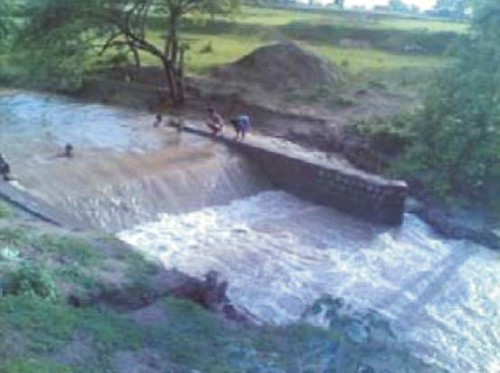
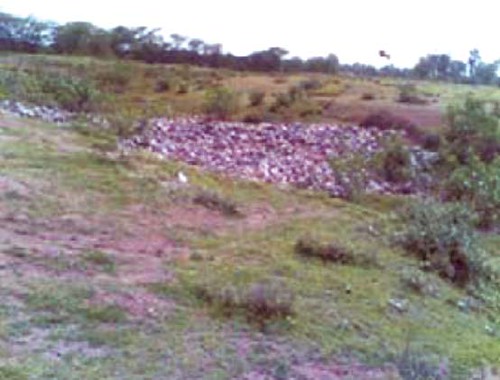
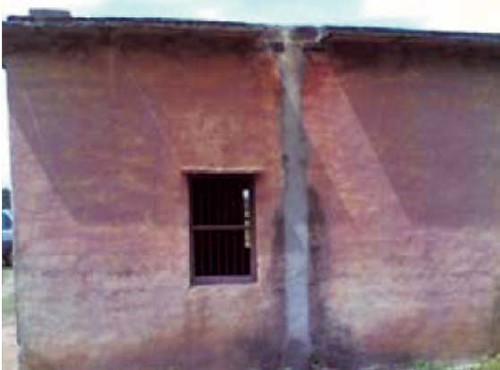 The VWSC also initiated construction of rooftop rainwater-harvesting structures comprising plastic drain -pipes from roof inserted into a pit comprising sand and gravel in all the 75 households, school and anganwadi in the village. Parhit, a local NGO, gave Rs 500 to each household and the balance amount of Rs 1000 to 1200 was contributed by the beneficiaries.
The VWSC also initiated construction of rooftop rainwater-harvesting structures comprising plastic drain -pipes from roof inserted into a pit comprising sand and gravel in all the 75 households, school and anganwadi in the village. Parhit, a local NGO, gave Rs 500 to each household and the balance amount of Rs 1000 to 1200 was contributed by the beneficiaries.For the village of Hamirpur, the journey began with an endeavor to cover all the households with minimum safe drinking water, which led to provision of adequate drinking water supply following the adoption of ‘Integrated Water Resource Management’ and large-scale construction of rainwater recharging structures. It is a unique experiment that has yieldedsignificant dividends.
Since the launching of the National Drinking Water Mission in 1987-88, which was renamedas Rajiv Gandhi National Drinking Water Mission, rainwater harvesting has been one of the major focus areas of the Department of Drinking Water Supply.
The Department launched a Sub-Mission on “Scientific source finding, conservation of water and recharge of aquifers” , which gave major emphasis on Rain Water Harvesting and a special fund was provided to all States with funding pattern of 75:25 between Government of India and State Government. A hand book on RainWater Harvesting and one on Technology and Water quality for Sustainability which includes rain water harvesting was published andcirculated to all the State Departments for adopting the same under Rural Water Supply Programme.
National Workshops on Sustainability of Drinking Water Supply Schemes were held in May 2007 and in June 2009 regarding different techniques of rainwater recharging structures to ensure sustainability of rural drinking water sources.
Under the National Rural Drinking Water Programme 20 percent of the allocation has beenearmarked for the Sustainability component. States will be provided 100 percent grant in aid by the Union Government for taking up water recharging structures to benefit drinking water sources and for rainwater harvesting.
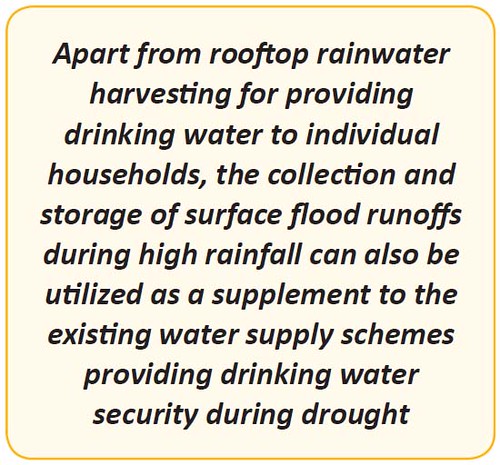
Bharat Nirman
Rural drinking water supply is one of the six components of Bharat Nirman. At the beginningof Bharat Nirman in 1/4/2005, out of 16.61 lakh rural habitations in the country, the Statesreported that 55,067 uncovered habitations, 3.31 lakh slipped back habitations and 2.17 quality affected habitations were remaining to be covered. Against 55,067 un-coveredhabitations to be covered during the Bharat Nirman period, 54,440 habitations have been covered by April, 2009. The remaining uncovered habitations will be covered by 2011.
The target of 3,31,604 slipped-back habitations has been exceeded by some states and not achieved in full by others. The habitations slip back due to many reasons such as sources going dry, lowering of the ground water table, systems outliving their lives, increase in population resulting in lower per capita availability, etc. The figures for slipped backhabitations are therefore dynamic. The States will tackle these habitations in their annual action plans.
Of the 2,16,968 quality affected habitations, in case of 50,168 habitations potable water isbeing supplied through completed projects. The remaining habitations targeted under BharatNirman and subsequent newly identified (due to more testing) quality affected habitations are being tackled through ongoing projects/approved projects to be started. Projects tackling water quality have long gestation periods and would not be completed by 2009. The targets have been continued in the XI Plan/Bharat Nirman Phase II and will be completedby 2011.
All States should have rooftop rainwater harvesting structures in rural areas for individualhouses as in Mizoram, Rajasthan and other states and especially in Government buildingsincluding Panchayats and school buildings. This should be made mandatory on thelines of the Government of Tamil Nadu Ordinance in this regard. In the North Eastern States and other hill areas, arid/semi-arid areas and coastal areas, in situ rain water harvestingshould be considered as the first option.
Convergence with the National Rural Employment Guarantee Scheme, Integrated WaterShed Development Programme, Backward Area Region Grants programme, XII th Finance Commission Grants and other programmes, is very important for promoting rain water harvesting and to get optimum results in bringing in sustainability of drinking water sources.
(Courtesy : PIB)
Posted by













